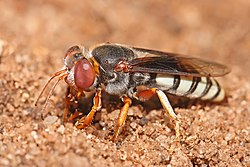Bembicini: Difference between revisions
this should be a redlink, and was misspelled |
Rescuing 1 sources and tagging 0 as dead. #IABot (v1.2.6) |
||
| Line 34: | Line 34: | ||
[[File:Bembix sp.jpg|thumb|left|250px|''Bembix sp.'' sand wasp]] |
[[File:Bembix sp.jpg|thumb|left|250px|''Bembix sp.'' sand wasp]] |
||
The '''Bembicini''', or '''sand wasps''', are a large [[Tribe (biology)|tribe]] of [[Crabronidae|crabronid]] [[wasp]]s, comprising 20 [[genera]]. Bembicines are [[predator]]s on various groups of [[insect]]s.<ref>http://www.waspweb.org/Apoidea/Crabronidae/Bembicinae/Bembicini/index.htm</ref> The type of prey captured tends to be rather consistent within each genus, with flies ([[Diptera]]) being the most common type of prey taken. Nests are typically short, simple burrows, with a single enlarged chamber at the bottom which is stocked with freshly killed prey items for the developing wasp [[larva]]; the egg may sometimes be laid before the chamber is completely stocked. It is common for numerous females to excavate nests within a small area where the soil is suitable, creating large and sometimes very dense nesting aggregations, which tend to attract various species of [[parasitism|parasitic]] flies and wasps, many of which are [[cleptoparasite]]s; in some cases, the sand wasps prey on their own [[parasite]]s, a surprisingly rare phenomenon in the animal kingdom.<ref>[[Howard E. Evans]], "A Review of Prey Choice in Bembicine Sand Wasps (Hymenoptera: Sphecidae)" ''Neotropical Entomology'' 31(1): 001-011 (2002) (PDF at [http://www.scielo.br/pdf/ne/v31n1/11172.pdf])</ref> Although sand wasps are normally yellow and black, some are black and white with bright green eyes. |
The '''Bembicini''', or '''sand wasps''', are a large [[Tribe (biology)|tribe]] of [[Crabronidae|crabronid]] [[wasp]]s, comprising 20 [[genera]]. Bembicines are [[predator]]s on various groups of [[insect]]s.<ref>{{cite web|url=http://www.waspweb.org/Apoidea/Crabronidae/Bembicinae/Bembicini/index.htm |title=Archived copy |accessdate=2015-10-31 |deadurl=yes |archiveurl=https://web.archive.org/web/20160304113918/http://www.waspweb.org/Apoidea/Crabronidae/Bembicinae/Bembicini/index.htm |archivedate=2016-03-04 |df= }}</ref> The type of prey captured tends to be rather consistent within each genus, with flies ([[Diptera]]) being the most common type of prey taken. Nests are typically short, simple burrows, with a single enlarged chamber at the bottom which is stocked with freshly killed prey items for the developing wasp [[larva]]; the egg may sometimes be laid before the chamber is completely stocked. It is common for numerous females to excavate nests within a small area where the soil is suitable, creating large and sometimes very dense nesting aggregations, which tend to attract various species of [[parasitism|parasitic]] flies and wasps, many of which are [[cleptoparasite]]s; in some cases, the sand wasps prey on their own [[parasite]]s, a surprisingly rare phenomenon in the animal kingdom.<ref>[[Howard E. Evans]], "A Review of Prey Choice in Bembicine Sand Wasps (Hymenoptera: Sphecidae)" ''Neotropical Entomology'' 31(1): 001-011 (2002) (PDF at [http://www.scielo.br/pdf/ne/v31n1/11172.pdf])</ref> Although sand wasps are normally yellow and black, some are black and white with bright green eyes. |
||
==See also== |
==See also== |
||
Revision as of 14:04, 30 October 2016
| Bembicini | |
|---|---|

| |
| Bembix sand wasp | |
| Scientific classification | |
| Kingdom: | |
| Phylum: | |
| Class: | |
| Order: | |
| Suborder: | |
| Superfamily: | |
| Family: | |
| Subfamily: | |
| Tribe: | Bembicini
|
| Genus | |

The Bembicini, or sand wasps, are a large tribe of crabronid wasps, comprising 20 genera. Bembicines are predators on various groups of insects.[1] The type of prey captured tends to be rather consistent within each genus, with flies (Diptera) being the most common type of prey taken. Nests are typically short, simple burrows, with a single enlarged chamber at the bottom which is stocked with freshly killed prey items for the developing wasp larva; the egg may sometimes be laid before the chamber is completely stocked. It is common for numerous females to excavate nests within a small area where the soil is suitable, creating large and sometimes very dense nesting aggregations, which tend to attract various species of parasitic flies and wasps, many of which are cleptoparasites; in some cases, the sand wasps prey on their own parasites, a surprisingly rare phenomenon in the animal kingdom.[2] Although sand wasps are normally yellow and black, some are black and white with bright green eyes.
See also
References
- ^ "Archived copy". Archived from the original on 2016-03-04. Retrieved 2015-10-31.
{{cite web}}: Unknown parameter|deadurl=ignored (|url-status=suggested) (help)CS1 maint: archived copy as title (link) - ^ Howard E. Evans, "A Review of Prey Choice in Bembicine Sand Wasps (Hymenoptera: Sphecidae)" Neotropical Entomology 31(1): 001-011 (2002) (PDF at [1])
